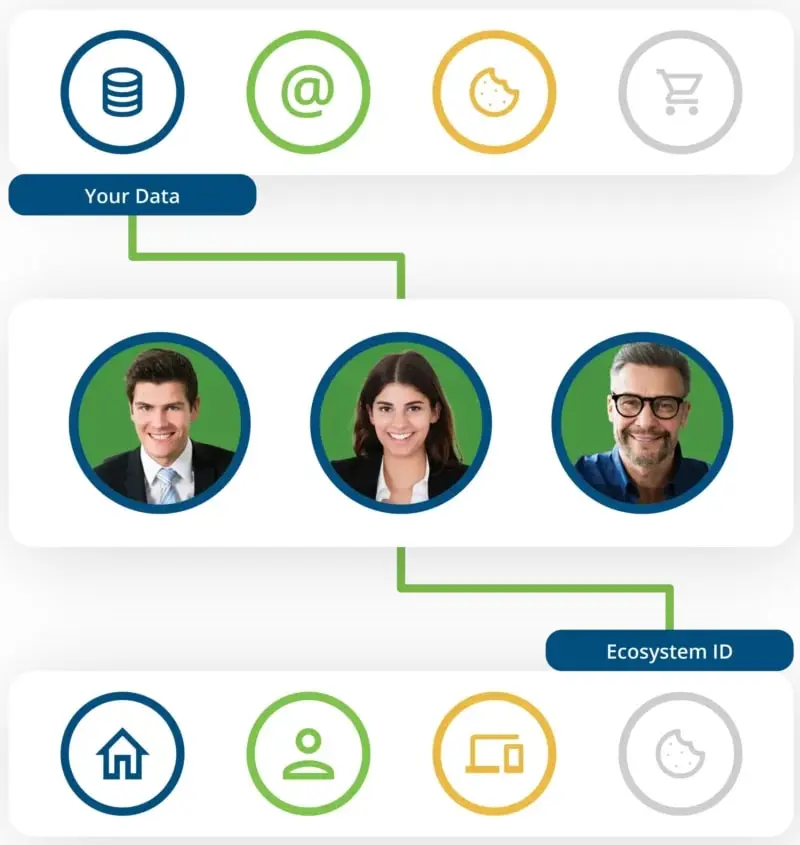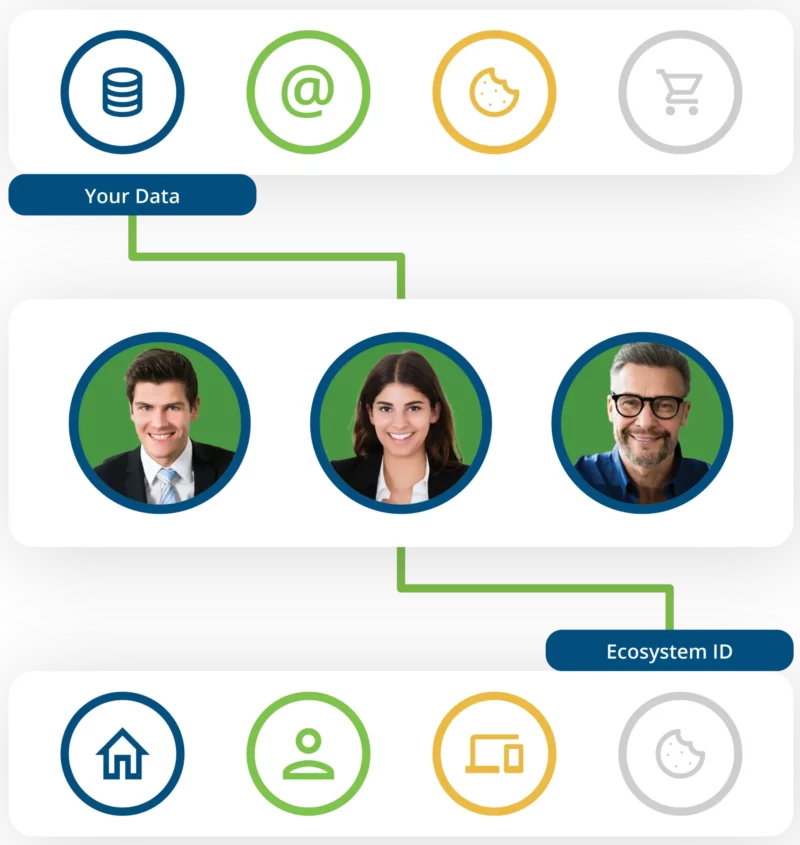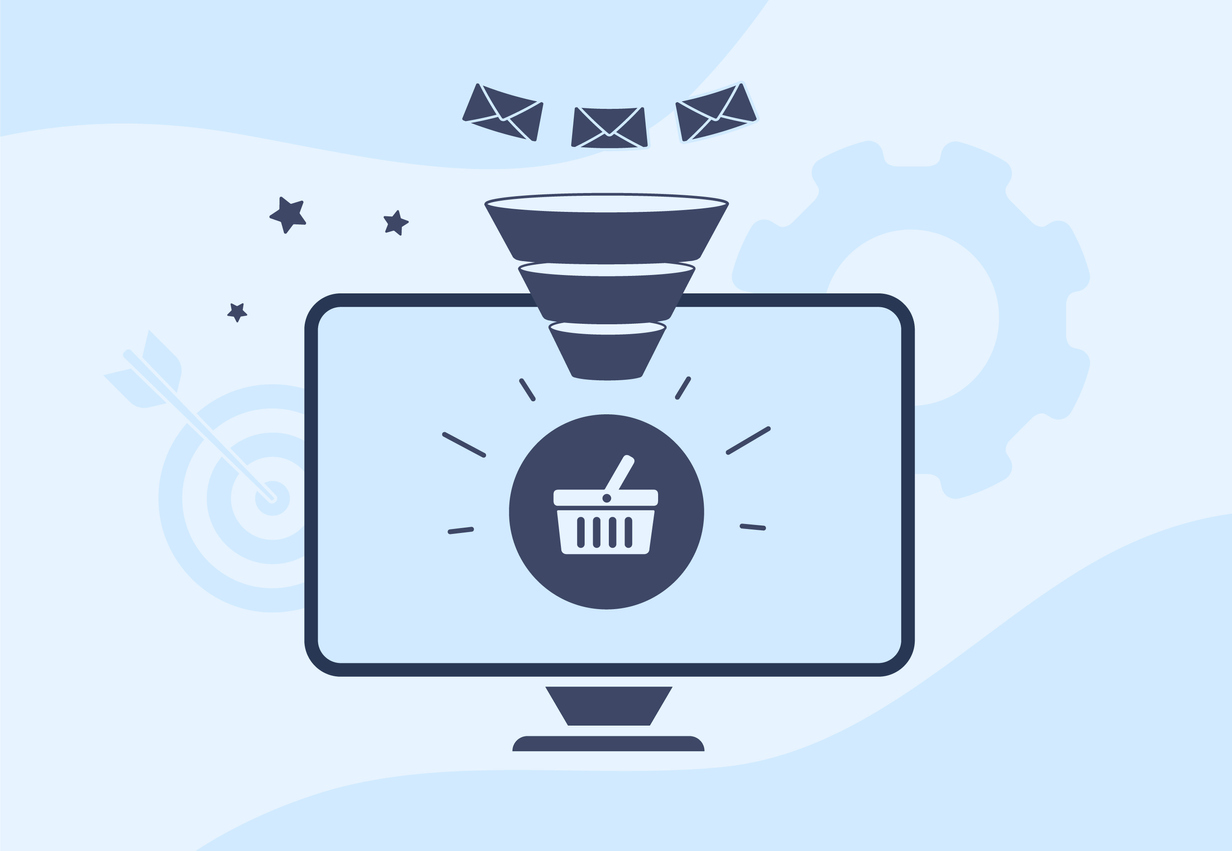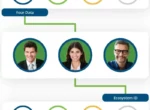
First-party data – data you collect with consent directly from your customers – has the power to revolutionize your marketing. It’s unique in many ways:
- It’s 100% accurate and reliable because it comes from your users.
- It allows you to deliver the personalized experiences that customers prefer.
- First-party data-driven campaigns convert better and reduce customer acquisition costs.
Why is first-party data so powerful, and how can you harness it to improve your campaigns? At Visual Visitor, we’re experts in turning first party data into better user experiences across email, advertising, and browsing. We provide the missing link between the data you already collect and the rest of your marketing efforts. Read on to learn what your data could be doing for you.

Why Identity Resolution using +Person Is Important
First-party data is information collected directly from your audience or customers through interactions with your brand.
Imagine every click, conversation, and purchase your customers make with your brand. This isn’t just data; it’s a narrative of their journey with you. First-party data captures these stories, offering an unfiltered glimpse into your audience’s desires and behaviors. First-party data is the dialogue between you and your customers.
Here’s a quick breakdown of the different kinds of data:
- Zero-Party Data: Data that customers actively give you, like preferences
- First-Party Data: Data that you collect directly and with consent when a customer interacts with your brand
- Second-Party Data: Data is collected directly by your data partners. I.e., other people’s first-party data.
- Third-Party Data: Data collected by parties you do not have a direct relationship with. This can aggregate data like demographics or individual information accessible in public databases.
First-party data provides businesses with rich insights into their audience, allowing for more personalized and effective marketing strategies. Businesses crave this direct line to their customers because it allows them to tailor marketing, crafting messages that resonate on a personal level. And in a world wary of data misuse, obtaining this treasure trove ethically helps you build trust – the most valuable part of the customer relationship.
The Value of Ethics in Data
Here’s the hard truth: trust is fragile. With headlines often screaming about data breaches, earning and keeping customer trust has become a Herculean task. Too many businesses have gotten sloppy, greedy, or both when handling user data. But ethical handling of first-party data isn’t just a legal checkbox—it’s a long-term strategy to gain and keep your customers’ trust.
People are wary of giving away their data for good reason. Showing that your business understands and respects privacy builds trust. On the other hand, abusing data and overreaching into personal lives can cause irreparable harm to any future relationship. When you turn personal data into action – say a marketing campaign – your first duty is to use ethical practices that build trust.
At Visual Visitor, we provide a wealth of additional information based on the first-party data you collect. You own the data and make the decisions regarding your use of it. But we always remind our customers what a certain arachnid-themed crime fighter learned: with great power comes great responsibility.
Turning First-Party Data into Trust and Revenue
With Visual Visitor’s product Web ID +Person, we use your first-party data to collect a wealth of information, including a visitor’s first and last name, email address, occupation, and 36 other data points. That’s just the raw material to work with. With that data, we help you build trust and drive revenue by showing your customers that you understand them and their needs. Here’s how:
Email: With detailed data, you can create email nurturing campaigns that recipients read. When emails are personalized and relevant, email open rates double or even triple. Feeding first-party data into your email workflow improves the efficiency of email campaigns in clearly measurable ways. Imagine: every message, every offer, feels like it’s made just for you. Plus, personalized email helps keep you out of the dreaded spam folder.
One-on-one advertising: Improve the efficiency of ad spend by creating more relevant ads targeted at highly qualified prospects. This applies to digital marketing, such as display ads and direct mail. Go beyond nurturing leads to a real conversation. Visual Visitor helps you deliver the right message to the right audiences for efficient and effective campaigns.
Segmentation and exclusion: Why waste money trying to contact people who are irrelevant to your marketing campaign? First-party data allows you to exclude groups of people from your marketing efforts, such as known customers, employees, or customers that can’t use your product, like people in other states. Furthermore, using data allows you to present personalized user experiences based on data, such as which pages they’ve already visited. Done well, every piece of content a user encounters takes them on a journey relevant to them.
Integration and automation: Visual Visitor helps you integrate a wealth of data into your existing automated systems and develop new automated systems to operationalize data. Integrating data with trusted partners can improve data security by limiting access to irrelevant or potentially harmful data.
This meticulous approach to data isn’t just effective; it’s transformative. Customers no longer feel like anonymous entries in a database. Instead, they’re recognized, understood, and valued.
First Party Data is a treasure trove of valuable insights, providing you with accurate and reliable information directly from your own customers and prospects.
Try Visual Visitor's +Person NowEthical Considerations of Using Data
Now that we’ve discussed the importance of trust and the power of data, let’s circle back to the point the half-man half-spider learned about great responsibility.
With the ability to access a wide range of demographic and personal data comes the need for strictly ethical data practices. Here’s what to watch out for:
Discrimination: The problem of discrimination exists worldwide, as does anti-discrimination legislation. When segmenting audiences and targeting communication, you never want to be prejudicial or limit access to opportunity. Especially in areas like housing and employment, check with qualified lawyers to ensure that your proposed practices are ethical and legal.
Consent: Consent continues to be a hot topic for web users and legislators. First-party data must be collected with informed and explicit consent. Make sure that your user consents to your collection of data, which is transparent and rescindable. If you operate in the European Union, ensure you comply with the General Data Protection Regulation (GDPR). Consider the California Consumer Privacy Act (CCPA) in the United States.
Data Security and Safety: Follow proper cyber security guidelines when handling first-party data. This includes anonymizing and pseudonymizing data to reduce the risk of identifying individuals. Threats include hackers from outside the organization and bad actors within your organization.
Remember that ethics and trust go hand in hand. If you genuinely want to nurture long-term customer relationships, you must give them every reason to trust you. Clearly explain how and why data is being used, stay on top of changing standards, and follow good cybersecurity practices to ensure your data powers are used for good and never evil.
Visual Visitor can help you collect and operationalize data to revolutionize your marketing effectiveness. Are you ready to implement the strategies above and convert more customers? We’re ready to make it happen.





